| Image search results - "R," |

Julia Domna
Stobi, Macedonia
2 assaria
Obv. Dr bust r, IVLIA - AVGV[STA] round.
Rev. Nike walking l, palm over l shoulder, wreath in raised r hand, wheel at her feet, MVNICI STO - BEN round.
5.57 gm, 23 mm
Cohen IV 266-267, BMCG 8
|
|

Julia Domna
Stobi, Macedonia
2 assaria
Obv. Dr bust r, IVLIA - AVGVSTA round.
Rev. Nike walking r, palm over l shoulder, wreath in raised r hand, MVNIC - S - TOBEN round
6.05 gm, 23 mm
Cohen IV 269, SNG Cop 332, Josifovski 212, same dies (V63, R68), citing Vienna 9885 [from whitetd49]
|
|

Julia Domna
Stobi, Macedonia
2 Assaria
Obv. Dr bust r, IVLIA · AV-GVSTA round
Rev. Nike walking r, palm over l shoulder, wreath in raised r hand, wheel at her feet, MVNICIP - STOBENSIV round.
5.08 gm, 23 mm
|
|

CLAUDIUS I As - 41/42 AD - Mint of Rome
Obv.: TI CLAVDIVS CAESAR AVG P M TR IMP
Bare head left
Rev.: S C across field, Minerva standing right, brandishing spear and holding shield on left arm.
Cohen 84var, RIC 100
g. 13,5 mm. 29,5 Maxentius
|
|

Denarius - 84 B.C. - Mint of Rome
P FVRIVS CRASSIPES - Gens Furia
Ob.: Turreted head of City or Cybele right, foot AED CVR and a foot behind
Rev. P FOVRIVS inscribed on curule chair, CRASSIPES in exergue.
Gs. 3,9 mm. 20,5x18,6
Craw. 356/1, Sear RCV 275
Maxentius
|
|

Tacitus, 25 September 275 - 12 April 276 A.D.
Obverse:
Laureate, draped and cuirassed bust right
AK K Î TAKITOC CEB
AK: AVTOKRATOR is the equivalent of the Latin Imperator, 'emperor'.
K Î is an abbreviation for K AV IOC, 'Claudius' transliterated into Greek.
TOK: TAKITOC= Tacitus
CEB: SEBASTOS (greek indication for augustus).
With the pellet between TOC . CEB
Reverse:
ETOVC A (year 1)
Dikaiosyne standing left holding scales in right hand and cornucopia in left. Diakaiosyne is the Greek equivalent of Aequitas ('Equity, Fair Dealing' to quote Sear).
Domination: Billon TETRAdrachm (4 drachms): size 21 mm
Mint: Alexandria, provincial.
Comment:
These Egyptian issues are not in RIC, but the old standard catalogue for these is Milne, where yours is no. 4492, with the pellet between TOC . CEB. They are also listed in the new Sear vol.III (though in not as much detail), where the nearest is 11831, which doesn't have the pellets in the obverse legend (Milne 4489). Other references : Curtis 1832, BMC 2403v ; Geissen 3115.
Peter Wissing
|
|
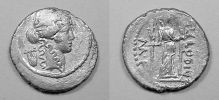
Denarius - 42 BC.
P. CLODIVS M.f. - Gens Claudia
Obv.: Laureate head of Apollo right, lyre behind
Rev.: Diana "Lucifera" standing facing, with bow and quiver over shoulder, holding lighted torch in each hand; P CLODIVS right, M F on left.
Gs. 3,3 mm. 19x18
Craw. 494/23, Sear RCV 492
Maxentius
|
|
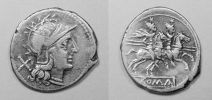
Anonymous Denarius - After 211 BC
Obv.: Helmeted head of Roma right, with triple earring, spike above visor, X behind.
Rev.: The Dioscuri riding right, ROMA in linear frame below.
Gs. 3,2 mm. 18,2x19,5
Cr44/5, Sear RCV 38
Maxentius
|
|

Denarius - 82 BC.
L. MARCIVS CENSORINVS - Gens Marcia
Obv.: Laureate head of Apollo right
Rev.: L CENSOR, the satyr Marsyas, standing left with wineskin over shoulder; behind him, column surmounted by Victory.
Gs. 3,7 mm. 18,3
Craw. 363/1d, Sear RCV 281
Maxentius
|
|

Denarius - 49 BC. - Mint in the East moving with Pompey.
Q. SICINIVS & C. COPONIVS - Gens Sicinia & gens Coponia
Obv.: Q. SICINIVS III. VIR, diademed head of Apollo right;
Rev.:C. COPONIVS. PR. S. C., club of Hercules with lion's skin, arrow & bow.
Gs. 3,6 mm. 17,8
Craw. 444/1b, Sear RCV 413.
Maxentius
|
|

Denarius - 46 BC.
MN. CORDIVS RVFVS - Gens Cordia
Obv.: Jugate heads of the Dioscuri right; stars above; RVFVS III VIR behind
Rev.: Venus stg. left, holding scales and sceptre; on her shoulder, Cupid. MN CORDIVS right.
Gs. 3,9 mm. 16x17,2
Craw. 463/1a; Sear RCV 440
Maxentius
|
|

NERO - Billon Tetradrachm of Alexandria - Year 12=65/66 AD.
Obv.:NERΩ KÎAÎ¥ KAIΣ ΣEB ÎER, radiate bust right, wearing aegis
Rev.: AÎ¥TOKPA, draped bust of Alexandria right in elephant skin headdress, LIB to right.
Gs. 12,65 mm. 26,9
Milne 238, Emmett 109
Maxentius
|
|

NVMERIANVS - Silvered AE Antoninianus - Lugdunum mint, 283/284 AD
Obv.: IMP C NVMERIANVS AVG, radiate cuirassed bust right
Rev.: PAX AVGG, Pax standing left holding branch & scepter, B to left.
Gs. 5,1 mm. 22,8
Cohen 43, RIC 393
Maxentius
|
|
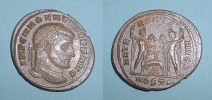
MAXENTIVS - Follis - Ostia mint - 309 AD
Obv.: IMP C MAXENTIVS P F AVG, laureate head right
Rev.: AETERNITAS AVG N, Castor and Pollux standing facing each other, each leaning on sceptre and holding bridled horse. In ex. MOSTA
Gs. 6,7 mm. 27,5
Cohen 10Maxentius
|
|

HADRIAN - Dupondius - 118 AD
Obv.: IMP CAESAR TRAIANVS HADRIANVS AVG, radiate and draped bust right;
Rev.: PONT MAX TR POT COS II. In ex. FORT RED / S C, Fortuna std. left holding rudder and cornucopiae
Gs. 13,2 mm. 26,8
Cohen 757var, RIC 557varMaxentius
|
|

TRAJAN - Denarius - 116 AD.
Obv.: IMP CAES NER TRAIAN OPTIM AVG GER DAC, laureate draped bust right
Rev.: PARTHICO P M TR P COS VI P P SPQR, Mars advancing right with trophy & spear.
Gs. 3,3 mm. 19,1
Cohen 190 Maxentius
|
|

Maxentius AE 28 Follis 308-310 AD.
IMP C MAXENTIVS PF AVG- Laureate head right.
CONSERV VRB SVAC-Roma seated left within hexastyle temple, holding globe & scepter, a shield to her right and wreath in pediment.
In ex: RBT Rome Mintnewone
|
|
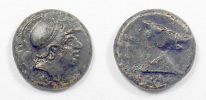
Anonymous AE Litra. 241-235 BC. (Grueber, half-litra: 312/290 BC)
Romano-Campanian
Obv.:Helmeted, beardless head of Mars right
Rev.:Head of horse right with bridle. A sickle behind, ROMA below.
Gs. 3,4 mm. 15,2
Crawford 25/3, Sear RCV 594, BMRRC II 64
Maxentius
|
|
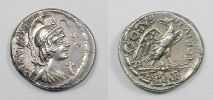
Denarius - 68/67 BC - Mint of Rome
M. PLAETORIVS M.f. CESTIANVS - Gens Plaetoria
Obv.: Bust of Vacuna right, wearing a wreathed and crested helmet, bow and quiver on shoulder, cornucopiae below chin. CESTIANVS left, S C right
Rev.: Eagle standing right on thunderbolt, head left. M PLAETORIVS M.F. AED CVR around.
Gs. 3,9 mm. 18
Craw. 409/1, Sear RCV 349, BMRRC 3596.
For Crawford, the goddess on obverse is Isis
Maxentius
|
|

Denarius - 111/110 B.C. Rome mint
APPIVS CL. PVLCHER, T. MALLIVS - Gens Mallia - Claudia.
Obv: Helmeted head of Roma right, quadrangular device behind
Rev.: Victory in triga right, T. MAL. (in monogr.) AP. CL. Q. VR. in ex.
Gs. 3,8 mm. 17,82
Crawf. 299/1b, Sear RCV 176, Grueber 1293
For Crawford, Q. VR would not mean Quaestores Urbani, but the name of a third moneyer, Q. Urbinius.Maxentius
|
|

Denarius - 116/115 BC. Rome mint (or in Italy)
CNAEVS DOMITIVS - Gens Domitia (Curtia)
Obv.: Helmeted head of Roma right with curl on left shoulder, ROMA before, X behind
Rev.: Jupiter in quadriga right with thunderbolt & branch, CN DOMI in ex.
Gs. 3,9 mm. 19,02x19,30
Crawf. 285/1, Sear RCV 161, Grueber II 490 (Italy)
Maxentius
|
|

MAXIMIAN AE3 (Half-follis). 317-318 AD- Posthumous issue struck under Constantine I. - Mint of Siscia
Obv.: DIVO MAXIMIANO SEN FORT IMP, laureate veiled bust right
Rev.: REQVIES OPTIMORVM MERITORVM, Emperor seated left on curule chair, raising hand & holding scepter, SIS in ex.
Gs. 1,7 mm. 17,1
RIC 41 (R3), Cohen 495
Maxentius
|
|

ISLANDS off THRACE, Thasos. Circa 500-480 BC
AR Drachm (19mm, 2.42 g)
Ithyphallic satyr running right, carrying off protesting nymph
Quadripartite incuse square
Le Rider, Thasiennes 3; SNG Copenhagen 1016; HGC 6, 332
Ardatirion
|
|

It is Antiochus VII Antioch SNG Spaer, 1911-1917
with winged eros on obverse
Coin #637
cars100
|
|
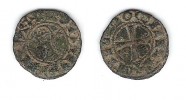
Crusader coin from the Principality of Antioch. Bohemond III. 1163-1201, Billon denier, Antioch Mint
|
|

Some English hammered silver, displayed in my cabinet.
www.CabinetsByCraig.netcmcdon0923
|
|

The seller identified this as from Trier, but now that I see the mintmark a bit clearer, I am thinking maybe it's an official issue from Heraclea?Matthew W2
|
|

Severus Alexander. AD232. AE Sestertius. Reverse.
obv: IMP ALEXANDER PIVS AVG - Laureate bust right, seen from front, draped and cuirassed.
rev: MARS VLTOR - Mars with spear and shield in the 'Ready-for-Action' position.
'S C' to either side of Mars.
22.3 grams.rexesq
|
|

Severus Alexander. AD232. AE Sestertius. Obverse.
obv: IMP ALEXANDER PIVS AVG - Laureate bust right, seen from front, draped and cuirassed.
rev: MARS VLTOR - Mars with spear and shield in the 'Ready-for-Action' position.
'S C' to either side of Mars.
22.3 grams.rexesq
|
|

Severus Alexander. AD232. AE Sestertius. Obverse.
obv: IMP ALEXANDER PIVS AVG - Laureate bust right, seen from front, draped and cuirassed.
rev: MARS VLTOR - Mars with spear and shield in the 'Ready-for-Action' position.
'S C' to either side of Mars.
22.3 grams.
**Photo w/ Flash
---
-rexesq
|
|

Severus Alexander AD 232 AE Sestertiusrexesq
|
|

Severus Alexander AD 232 AE Sestertiusrexesq
|
|

Fourree Denarius, Severus Alexander, copying RIC 196
Obv: IMP SEV ALEXANDER AVG
Laureate head right, drapery on left shoulder
Double strike
Rev: FORTVNAE REDVCI
Fortuna standing left, holding rudder on globe and cornucopiae.
18mm, 3.04g
klausklage
|
|

Obv.IMP CAESAR TRAJAN HADRIANVS AVG Laur bust of hadrian.r, with light drapery on far shoulder. Rev VOT PUB(in field) PM T RP COS III. Pietas,stg,r,both hands raised.RIC 141 (rome ad 119) weight 3,25grspikbjorn
|
|

Empress Faustina Sr.(138-141 AD)
Wife of Emperor Antoninus Pius (138 - 161 AD)
Bronze Dupondius or As, Most Likely an As.
Rome Mint
obv: DIVA FAVSTINA - Draped bust right
rev: AETERNITAS - Aeternitas seated left on starry globe, right hand outstretched, left hand holding sceptre. SC in exergue.
11.0 Gramsrexesq
|
|

Antoninus Pius
Empress Faustina Sr.(138-141 AD)
Wife of Emperor Antoninus Pius (138 - 161 AD)
Bronze Dupondius or As, Most Likely an As.
Rome Mint
obv: DIVA FAVSTINA - Draped bust right
rev: AETERNITAS - Aeternitas seated left on starry globe, right hand outstretched, left hand holding sceptre. SC in exergue.
11.0 Gramsrexesq
|
|

Emperor Severus Alexander. AD232. AE Sestertius. Reverse, cut.
obv: IMP ALEXANDER PIVS AVG - Laureate bust right, seen from front, draped and cuirassed.
rev: MARS VLTOR - Mars with spear and shield in the 'Ready-for-Action' position.
'S C' to either side of Mars.
22.3 grams.rexesq
|
|

Emperor Severus Alexander. AD232. AE Sestertius. Reverse, cut.
obv: IMP ALEXANDER PIVS AVG - Laureate bust right, seen from front, draped and cuirassed.
rev: MARS VLTOR - Mars with spear and shield in the 'Ready-for-Action' position.
'S C' to either side of Mars.
22.3 grams.
--------------------------
Fantastic 'MARS ULTOR' reverse!rexesq
|
|

Emperor Severus Alexander. AD232. AE Sestertius. Reverse.
obv: IMP ALEXANDER PIVS AVG - Laureate bust right, seen from front, draped and cuirassed.
rev: MARS VLTOR - Mars with spear and shield in the 'Ready-for-Action' position.
'S C' to either side of Mars.
22.3 grams.
--------------------------
Fantastic 'MARS ULTOR' reverse!!rexesq
|
|

Emperor Severus Alexander. AD232. AE Sestertius. Obverse.
obv: IMP ALEXANDER PIVS AVG - Laureate bust right, seen from front, draped and cuirassed.
rev: MARS VLTOR - Mars with spear and shield in the 'Ready-for-Action' position.
'S C' to either side of Mars.
22.3 grams.rexesq
|
|
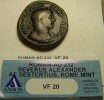
Emperor Severus Alexander. AD232. AE Sestertius. Obverse.
obv: IMP ALEXANDER PIVS AVG - Laureate bust right, seen from front, draped and cuirassed.
rev: MARS VLTOR - Mars with spear and shield in the 'Ready-for-Action' position.
'S C' to either side of Mars.
22.3 grams.rexesq
|
|

Obverse: DN MAVRC TIB PP AVG or similar, Helmeted sometimes crowned, and cuir. Bust facing, holding gl. cr., and shield.
Reverse: Large K ANNO to left, cross above, regnal yr 3 (III) to rt. but the mint mark sometimes reads TE, TH,TEC or backward S < E< and T, instead of TES.
Mint: Thessalonica
Date: 584/5 CE
Sear 509, DO 74-90
18mm, 5.90gwileyc
|
|

Severus Alexander
Ancient Rome
Emperor Severus Alexander(222 - 232 AD) AE (Bronze) Sestertius
Struck at the Rome Mint in AD 229 - 230.
obv: IMP SEV ALEXANDER AVG - Laureate bust right, drapery on left shoulder.
rev: P M TR P VIII COS III P P - Emperor riding in quadriga right holding eagle tipped sceptre in one hand and holding the reigns in the other.
'SC' below, in exergue.
Weight: 21 Grams
Size: 32 - 33 mm
References: Cohen 377, RIC 495 rexesq
|
|

Severus Alexander
Ancient Rome
Emperor Severus Alexander(222 - 232 AD) AE (Bronze) Sestertius
Struck at the Rome Mint in AD 229 - 230.
obv: IMP SEV ALEXANDER AVG - Laureate bust right, drapery on left shoulder.
rev: P M TR P VIII COS III P P - Emperor riding in quadriga right holding eagle tipped sceptre in one hand and holding the reigns in the other.
'SC' below, in exergue.
Weight: 21 Grams
Size: 32 mm - 33 mm
References: Cohen 377, RIC 495
-----------------------
~*~I will most likely be taking this coin out of it's plastic prison soon. I will post more pics after doing so.~*~rexesq
|
|

Severus Alexander
Ancient Rome
Emperor Severus Alexander(222 - 232 AD) AE (Bronze) Sestertius
Struck at the Rome Mint in AD 229 - 230.
obv: IMP SEV ALEXANDER AVG - Laureate bust right, drapery on left shoulder.
rev: P M TR P VIII COS III P P - Emperor riding in quadriga right holding eagle tipped sceptre in one hand and holding the reigns in the other.
'SC' below, in exergue.
Weight: 21 Grams
Size: 32 mm - 33 mmrexesq
|
|

Severus Alexander
Ancient Rome
Emperor Severus Alexander(222 - 232 AD) AE (Bronze) Sestertius
Struck at the Rome Mint in AD 229 - 230.
obv: IMP SEV ALEXANDER AVG - Laureate bust right, drapery on left shoulder.
rev: P M TR P VIII COS III P P - Emperor riding in quadriga right holding eagle tipped sceptre in one hand and holding the reigns in the other.
'SC' below, in exergue.
Weight: 21 Grams
Size: 32 mm - 33 mmrexesq
|
|

Severus Alexander
Ancient Rome
Emperor Severus Alexander(222 - 232 AD) AE (Bronze) Sestertius
Struck at the Rome Mint in AD 229 - 230.
obv: IMP SEV ALEXANDER AVG - Laureate bust right, drapery on left shoulder.
rev: P M TR P VIII COS III P P - Emperor riding in quadriga right holding eagle tipped sceptre in one hand and holding the reigns in the other.
'SC' below, in exergue.
Weight: 21 Grams
Size: 32 mm - 33 mmrexesq
|
|

Macedonia, Pella AE21. 158-149 BC. Bust of Pan / Athena Alkidemos advancing right. Ref.Sear 1445
( I was given this coin as a bonus by an experienced collector / dealer, to attempt electrolysis on, he had been attempting to clean it with conventional methods for 1½ years, however it remained a nugget... I know some members will object, but 10 minuets in the bath of evil, and the crust just flaked off revealing a pretty and detailed coin!!! How I wish it was always so easy!!)Lee S
|
|

AE sestertius. Struck under Claudius, circa 50-54 AD, uncertain eastern provincial mint located in the modern-day Balkans.
Obv : TI CLAVDIVS CAESAR AVG F BRITANNICVS, draped bust left.
Rev : - No legend, Mars advancing left, holding spear and shield, SC in fields. 35mm, 19.4g. Extremely Rare.
Ref : BMCRE 226
Cohen 2
RCV 1908, valued at $32,000 in Fine, which is a few multiples greater than any other sestertius issued during the several centuries the denomination was in use.
A large number of the surviving examples of this series (one may even suggest a majority of them), due to their rarity, have been subjected to modern alteration techniques such as smoothing, tooling, and repatination. As such, it's actually pleasant to see a bit of field roughness and a 'plain brown' patina of old copper on this example, evidence that it is just as ugly as it was the day it was last used in circulation back in Ancient Rome.
Britannicus, originally known as Germanicus after Claudius' older brother, was the emperor's original intended heir and natural son. Machinations by Agrippina II eventually saw Britannicus supplanted by her own son Nero, (by Lucius Domitius Ahenobarbus) who took the throne upon Claudius' suspicious death. Britannicus himself died a few years later, reportedly poisoned by his step-brother. The future emperor Titus and Britannicus were close friends, and Titus became quite ill and nearly died after eating from the same poisoned dish that killed Britannicus.R. Smits
|
|

Bayern
Stadtgemeinde Lauf
10 Pfennig
1917
Prägeanstalt: C. Balmberger, Nürnberg
Vs.: Wappen
Rs.: WZ im Blätterkranz
Rand: Glatt
Literatur: Menzel 7754.2
Erhaltung: Fast vorzüglich / sehr schön
Metall: Zink
20 mm, 1,68 g _383
Antonivs Protti
|
|

didrachm, 330/290 BC
7.82 g
obv: head of Demeter left
rev: ear of grain, tongs to left, META to right
(Johnston C 4.20 (this coin); Rutter, Historia Numorum 1583)
from Ars Classica 15, Luzern 1930, No. 167, ex Künker e-Auction 17, No. 7areich
|
|

Deutsches Reich -- Kaiserreich
Wilhelm II. 1888-1918
1/2 Mark 1918 D
München
Vorderseite: Jahr und Wert zwischen Eichenzweigen.
Rückseite: Adler zwischen Eichenzweigen.
Erhaltung: Fast Stempelglanz.
Metall: Silber, .900 fein.
Gewicht: 2,7 g.
Durchmesser: 20 mm. _792Antonivs Protti
|
|

Medaillen
Deutsches Reich
Johann Christoph Friedrich von Schiller war ein bedeutender deutsche Dichter, Dramatiker, Philosoph und Historiker (*1759 in Marbach am Neckar, + 1805 in Weimar)
Zinnmedaille
Signiert W.S (Wenzel Seidan)
Undatiert (1859)
Auf den 100. Geburtstag Schillers gewidmet vom Prager Schiller-Verein
Vs: Umschrift, darin bekleidetes Brustbild nach rechts.
Rs: Sieben Zeilen Schrift zwischen zwei Lorbeerzweigen
7,5 g ; 26,0 mm
Kleine Randunebenheiten, Vorzüglich _1193Antonivs Protti
|
|

Dänemark
Christian XI. 1863-1906
2 Ãre
1886
Münzstätte: Kopenhagen
Vs.: Gekröntes Monogramm
Rs.: Nominal flankiert von Delfin und Ãhre
Zitat: KM# 793.1
Erhaltung: Kratzer, ansonsten sehr schön - fast vorzüglich
Metall: Bronze
21 mm, 3,79 g _399Antonivs Protti
|
|

RDR -- Haus Habsburg
Franz II. (1792-1806-1835)
1800
6 Kreuzer (Kupfer)
Münzstätte: Wien (A)
Vs: Kopf nach rechts, darunter in Verzierung Münzzeichen (A). Umschrift: "FRANZâ¢IIâ¢RÃMâ¢KAIâ¢KÃNâ¢Zâ¢HUâ¢Uâ¢BÃâ¢ERZH⢠Zâ¢OESTâ¢"
Rs: unter Krone Doppeladler, auf der Brust Wertzahl. Umschrift: "SECHSâ¢KREUTZERâ¢ERBLAENDISCHâ¢1800â¢"
Gewicht: 12,4g
Durchmesser: 31 mm
Erhaltung: schön _799Antonivs Protti
|
|

Libyen
Idris I. 1951-1969
2 Milliemes
AD 1952
Vs.: König Idris I. n. r.
Rs.: Nominal über Jahr, das Ganze im Kranz, oben Krone
Rand: Glatt
Erhaltung: Sehr schön
Metall: Bronze
24 mm, 6,08 g _396Antonivs Protti
|
|

Stadt Rostock
3 Pfennig 1859 BS ( Benjamin Steinhorst)
Greif nach links.
Rs: Wert, Jahr und Mmz.
Erhaltung: Randfehler, sehr schön.
Durchmesser: 21 mm
Gewicht: 2,8 g (Cu) _1999Antonivs Protti
|
|

Deutsches Reich
Preussen
Königreich
Wilhelm II. (1888-1918)
2 Mark 1901
Münzstätte: Berlin
Anlässlich des 200jährigen Bestehen des Königreiches
Vorderseite: "+FRIEDRICH.I.1701. WILHELM.II.1901." um gestaffelte Brustbilder (nach links), das vordere mit gekröntem Adler auf Helm
Rückseite: "DEUTSCHES REICH 1901 / * ZWEI MARK *" um Krone über Adler mit Wappenschild auf Brusthöhe
Rand geriffelt
feine Kratzer, Vorzüglich / Stempelglanz
Silber (900/1000)
11,1g
Durchmesser ca. 28mm
AKS # 136
Jaeger # 105 _2998Antonivs Protti
|
|

Römisch Deutsches Reich - Münster, Domkapitel
VI Pfennig 1762, Münzstätte Münster,
Hl. Paulus mit Bibel und Schwert.
Rs: Wert und Jahr.
Erhaltung: Schön.
Durchmesser: 25 mm
Gewicht: 3,2 g (Cu) _692Antonivs Protti
|
|

Römisch Deutsches Reich - Münster, Domkapitel
III Pfennig 1758 (?), Münster
Heiliger Paulus mit Bibel und Schwert
Rs: Jahreszahl und Wertzahl
Erhaltung: Fast sehr schön.
Durchmesser: 23 mm
Gewicht: 3,8 g (Cu) _691Antonivs Protti
|
|

GEORGIAN KINGDOM, QUEEN TAMAR, (1184-1213 AD) K'ORONIKON, 420 = 1200 AD; Obv.: Bagratid royal emblem in the form of a standard, to left and right: Initials for T'amar and David; in the corners, Georgian date formula, K'K VÃ K (420 of the Paschal cycle = AD 1200). Two Counterstamps. Rev.: Christian inscriptions in arabic script, which reads: 1st line: Malekat al-Malekaat(s) / 2nd line Jellal Al-Dunya Wal Din / 3rd line : Tamar Ibnat Kurki / 4th line : Zahir Al-Massih. Translation: Queen of Queens Glory of the World and Faith T'amar daughter of Giorgi Champion of the Messiah. Reference: LANG # 11.
Reverse inscriptions read :
Ãâ¦ÃâÃÆé çÃâÃâ¦ÃâÃÆçê
ìÃâçÃâ çÃâïÃâ Êç ÃË Ã§ÃâïÃÅ Ãâ
êÃâ¦Ã§Ã± çèÃâ é ÃÆÃËñÃÆÃâ°
øÃâ¡ÃŠñ çÃâÃâ¦Ã³ÃŠàdpaul7
|
|

FAUSTINA I
AE As
26.5mm, 14.2 grams
OBV: DIVA FAVSTINA, Faustina head right.
REV: AETERNITAS, Pietas standing left by alter, raising right hand and holding box of incense.
S-C in field
RIC- III- 1161
|
|

SEVERUS ALEXANDER
AE As 233 A.D.
26.1 mm, 11.9 grams
OBV: IMP CAES M AVR SEV ALEXANDER AVG, laureate, draped bust right.
REV: PONTIF M TR P II COS P P, Securitas seated left, by lighted alter, holding scepter and supporting her head on left hand.
S-C under.
RIC- IVb- 409
|
|

GORDIAN III
Sestertius 243-244 AD.
30 mm,18.7 grams
OBV: IMP GORDIANVS PIVS FEL AVG, laureate, draped & cuirassed bust right.
REV: VICTORIA AETER, Victory standing left, resting shield upon a captive at foot left & holding palm.
RIC-IVc-337a
|
|
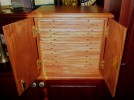
A cabinet I built for a collector, featuring 18 trays and locking doors.
www.CabinetsByCraig.netcmcdon0923
|
|

An example of a cabinet built for a collector, and friend of mine.
www.CabinetsByCraig.netcmcdon0923
|
|

Roman Provincial Trajan, AE23, of Tabae, Caria, 5.1g, 24mm
Obverse: AVK A TPAIANOC APIÎCÎA, Laureate head right.
Reverse: TABHNΩN, Demeter, polos on head, standing left, holding grain ears, bunch of grapes and sceptre.
Reference: SNG Cop 559, Hunter 4.
Gil-galad
|
|

Georgia Georgia and Armenia as part of the Iranian state
Nâdir Shâh Afshâr, 1148-1160 H./1735-1747 AD Rupee 1152 H. Tiflîs. Album 2744 Lang 89
Quant.Geek
|
|

Abbasid Governors, anonymous, AE fals (21mm, 3.71gm, 11h), Halab, AH 136. O: Kalima; below, large pellet left and annulet right; in margin, mint and date formula. R: At center, Kalima continued; in margin, Qur'an 9:33. Ilisch (1996) Resafa IV, p. 117, 221 (dated xx6); cf. ibid. 220 (dated 135) and 222 (date illegible, either 135 or 136); see also Nützel (1898) Berlin 2074 (dated 135 but mint illegible) and Shamma p. 89, 3 (dated xx5). Very Fine and extremely rare, olive green patina with areas of red sand encrustation. Date full and clear. Mint missing but clearly style of Halab, AH 135 and 136.Quant.Geek
|
|
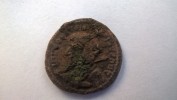
OBVERSE - IMP CONSTANTINVS AVG
high-crested helmet, cuirassed, spear across right shoulder
REVERSE - VICTORIAE LAETE PRINC PERP
TWO VICTORIES RESTING SHIELD, INSCRIBED VOT P R ON ALTAR - CONCAVE ROUND TOP ALTAR, WITH GARLAND AND TOP DOT OF GARLAND JUST UNDER ROUND TOP.
UNKNOWN IN EX. ?? UNKNOWN MINT ??
DIMENSION = 19mm
WEIGHT = 3 grams
MATERIAL = BRONZE ?
|
|
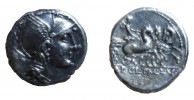
Denarius
Appius Claudius Pulcher, T Manlius Mancinus & Q Urbinus
Mint: Rome
111-110 BCE
Obverse: Helmeted head of Roma, right; behind, mark (circle within a triangle); border of dots
Reverse: Victory in triga right, holding reins in both hands, one horse looking back; AP CL T MAL Q VR in exergue; border of dots
Crawford (RRC) 299/1a
Sydenham 570
RSC I Mallia 1
SRCV I 176
|
|

FATIMID: al-Mustansir, 1036-1094, AV dinar (4.08g), Misr, AH429. A-719.1. Nicol-2104. Quant.Geek
|
|

AE 3; 20mm, struck c. 319 AD
Con/ VF; brown patina.
Obv/ LICINIVS IVN NOB CAES; laur., dr. and cuir. bust r.
Rev/ VICTORIAE LAETAE PRINC PERP; two Victories stg. facing each other, together holding a shield inscribed VOT PR on an altar inscribed with the letter S. Gamma SIS pellet in exergue.
Ref/ RIC VII 70 = Rare 3Mayadigger
|
|

Maximus Crowvs
Maximus (Caesar, 235/6-238). AR Denarius Rome mint, 236-7.
O: MAXIMVS CAES GERM; Rvssell Crowvs Bareheaded and draped bust right
R: PRINC IVVENTVTIS; Maximus standing left, holding baton and spear; two signa to right
- RIC IV ?Nemonater
|
|

AE Onkia, 2.11 g, Sicily, Panormos, ca. 415-380 B.C. Obv: Forepart of Man-headed bull facing left, possibly ear of corn above or simply an encrustation divided from the man-faced bull by the tooler, in which case SYS should be above. Rev: Horse trotting right, ear of corn above. Calciati I, 272, no. 11. Hoover HGC 2, 1062 (this coin); Giuseppe Bucetti "Monete, Storia e topografia della Sicilia Greca," p. 344 (this coin); MSP I, 48b (this coin illustrated).
Definite tooling around the major devices, on the legs and back. Face apparently untouched though field in front has been smoothed.
Ex. Dr. Busso-Peus, Auction 386, No. 108 (unsold). Tooled.Molinari
|
|

John Comnenus-Ducas. As emperor of Thessalonica, 1237-1242. BI Trachy (20mm, 1.67 g, 6h). Type R, Variety A. Thessalonica mint. Outstretched wing to left / Facing half-length bust John, holding banner decorated with two cross-in-rings. DOC 31; SB 2217. VF, dark green and brown patina, hint of roughness, small flan split.
From the Iconodule Collection.Quant.Geek
|
|

SIKH EMPIRE: AE paisa (11.77g), Amritsar, VS(188)0, KM-4, Herrli-01.30.11Quant.Geek
|
|

SIKH EMPIRE: AE ¼ anna (7.35g), Amritsar, VS(18)96, KM-5var, Herrli-01.31, small cross in obverse field, pa anna nanakshahi on reverse, lovely strike, gorgeous EF, R, ex Paul Stevens Collection. Herrli divided these into a paisa (=¼ anna) and half paisa (11-12g, and 5.5g, respectively), but all coins are inscribed "pa anna" for ¼ anna, and all weigh in the range of 7.0g to 8.5g; thus there is only one denomination for this type.
Quant.Geek
|
|

Heraclius & Heraclius Constantine overstruck on Phocas & Leontia . 610-641 / 602-610. à follis (26.89 mm, 8.78 g, 6 h). Host coin, Theopolis (Antioch) mint, 602-610 / after 610. overstrike, Thessalonica mint. Overstrike: fragmentary, d N hÃâRA[CLIçS PP AVG] �Host coin, also fragmentary, [O N FOCA] NÃâ PÃâ [AV] , Overstrike: Heraclius (on left, and Heraclius constantine, barely visible on right) standing facing, each holding globus cruciger, cross between their heads �Host coin: Phocas on left and Leontia standing facing; Emperor holds globus cruciger, Empress holds cruciform scepter; cross between their heads / Overstrike, large M between A / N / N / O and date (not struck-up), cross above, B below, ÃËÃâC in exergue�Host coin, large m between [A / N /] N / O and date (unclear) cross above, ThÃâçP' in exergue. Host coin, Cf. SBCV 671; Overstrike, Cf. SBCV 824. VF for type, dark green patina on devices, lighter encrustation on fields - overstrike at ~ 90º ccw. ��
multiply struck: host coin is Phocas & Leontia from Antioch, SBCV 671 or similar �overstrike, at ~ 90º ccw, is Heraclius from Thessalonica Quant.Geek
|
|

Justinian I. 527-565. Ã pentanummium (18.01 mm, 2.49 g, 1 h). D N IVSTINI-ANVS AVG, diademed, draped and cuirassed bust of Justinian I right / large Ãâ with crossbar in center, to right, lunate V. SB 243; DOC 270. Quant.Geek
|
|

PHOCAS (602-610). Follis. Cyzicus. Dated RY 1 (602/3). Obv: Phocas, holding globus cruciger, and Leontia, holding cruciform sceptre, standing facing. Rev: Large M; cross above, A/N/N/O - I across field; KYZA. Sear 664. Condition: Good very fine. Weight: 13.74 g. Diameter: 30 mm.Quant.Geek
|
|

Moeda Brasil 1935- 1000 Reis
Serie Ilustres - Padre Anchieta
Módulo Maior - Escassa
________________________________
ANVERSO
EfÃgie do Padre José de Anchieta, de perfil, onde
se ostenta a inscrição vertical ANCHIETA.
Missionário e fundador de São Paulo.
Sigla do gravador Calmon Barreto.
REVERSO
No centro, um livro aberto e o valor 1000 réis em
semicÃrculo. Sob o valor, a data. No exergo, a palavra
BRASIL. Sigla do gravador Walter Toledo.
PADRÃO MONETÃRIO
MIL-RÃIS (de 08/10/1833 a 31/10/1942)
PERÃODO POLÃTICO
República, Era Vargas (1930-1945)
ORIGEM
Casa da Moeda, Rio de Janeiro
CARACTERÃSTICAS
Material: bronze alumÃnio
Diâmetro: 26,7 mm
Peso: 8,00 g
Espessura: 2,10 mm
Bordo: serrilhadoAntonivs Protti
|
|

Postumus. Romano-Gallic Emperor, A.D. 260-269. BI antoninianus (20 mm, 3.04 g, 7 h). Treveri, A.D. 266. IMP C POSTVMVS P F AVG, radiate, draped and cuirassed bust of Postumus right / FIDES [E]XERCITVS, four military standards. RIC 303; Mairat 120; AGK 20; RSC 65. Quant.Geek
|
|

ARAB-BYZANTINE: Standing Emperor, ca. 680s, AE fals, Dimashq, A-3517.2, bird on T left, mint name in Greek to right / anchor above and downward crescent below M, Arabic duriba / dimashq / ja'iz around
Dim: 4.35g, 6 h
Quant.Geek
|
|

Justin II, with Sophia. 565-578. Ã Half Follis (20mm, 6.62 g, 6h). Thessalonica mint. Dated RY 8 (572/3). Nimbate figures of Justin and Sophia seated facing on double throne, holding globus cruciger and cruciform scepter, respectively / Large K; cross above, date across field; TÃâS. DOC 73; MIBE 70a; SB 366. Quant.Geek
|
|

EDWARD IV
Edward IV was King of England from March 1461 to October 1470, and again from April 1471 until his sudden death in 1483. He was the first Yorkist King of England. The first half of his rule was marred by the violence associated with the Wars of the Roses, but he overcame the Lancastrian challenge to the throne at Tewkesbury in 1471 and there were no further rebellions in England during the rest of his reign.
In 1475, Edward declared war on France, landing at Calais in June. However, his ally Charles the Bold, Duke of Burgundy, failed to provide any significant military assistance leading Edward to undertake negotiations with the French, with whom he came to terms under the Treaty of Picquigny. France provided him with an immediate payment of 75,000 crowns and a yearly pension of 50,000 crowns, thus allowing him to "recoup his finances". Edward also backed an attempt by Alexander Stewart, 1st Duke of Albany and brother of King James III of Scotland, to take the Scottish throne in 1482. Edward's younger brother, the Duke of Gloucester (and future King Richard III) led an invasion of Scotland that resulted in the capture of Edinburgh and the Scottish king himself. Alexander Stewart, however, reneged on his agreement with Edward. The Duke of Gloucester then withdrew from his position in Edinburgh, though he did retain Berwick-upon-Tweed.
Edward became subject to an increasing number of ailments when his health began to fail and he fell fatally ill at Easter in 1483. He survived long enough though to add some codicils to his will, the most important being to name his brother Richard, Duke of Gloucester as Protector after his death. He died on 9th April 1483 and was buried in St George's Chapel, Windsor Castle. He was succeeded first by his twelve-year-old son Edward V of England, who was never crowned, and then by his brother who reigned as Richard III.
It is not known what actually caused Edward's death. Pneumonia, typhoid and poison have all been conjectured, but some have attributed his death to an unhealthy lifestyle because he had become stout and inactive in the years before his death.*Alex
|
|

JAMES IV OF SCOTLAND
James IV was the King of Scotland from June 1488 until his death in battle at the age of 40 on the 9th September, 1513.
James IV's mother, Margaret of Denmark, was more popular than his father, James III, and though somewhat estranged from her husband she raised their sons at Stirling Castle until she died in 1486. Two years later, a rebellion broke out, where the rebels set up the 15-year-old Prince James as their nominal leader. The rebels fought James III at the Battle of Sauchieburn where, on 11th June 1488, the king was killed. Prince James assumed the throne as James IV and was crowned at Scone on 24th of June. However he continued to bear an intense guilt for the indirect role which he had played in the death of his father.
James maintained Scotland's traditional good relations with France, and this occasionally created diplomatic problems with England, but James recognised nonetheless that peace between Scotland and England was in the interest of both countries, and established good diplomatic relations with England as well. First he ratified the Treaty of Ayton in 1497, then, in 1502 James signed the Treaty of Perpetual Peace with Henry VII which was sealed by his marriage to Henry's daughter Margaret Tudor the next year. Anglo-Scottish relations generally remained stable until the death of Henry VII in 1509.
James saw the importance of building a fleet that could provide Scotland with a strong maritime presence, he founded two new dockyards and acquired a total of 38 ships for the Royal Scots Navy. These including the "Great Michael" which, built at great expense, was launched in 1511 and was at that time the largest ship in the world.
When war broke out between England and France, James found himself in a difficult position as an ally by treaty to both countries. But relations with England had worsened since the accession of Henry VIII, and when Henry invaded France, James reacted by declaring war on England.
James sent the Scottish navy, including the "Great Michael", to join the ships of Louis XII of France and, hoping to take advantage of Henry's absence at the siege of Thérouanne, he himself led an invading army southward into Northumberland. However, on 9th September 1513 at the disastrous Battle of Flodden James IV was killed, he was the last monarch in Great Britain to be killed in battle. His death, along with many of his nobles including his son the archbishop of St Andrews, was one of the worst military defeats in Scotland's history and the loss of such a large portion of the political community was a major blow to the realm. James IV's corpse was identified after the battle and taken to Berwick, where it was embalmed and placed in a lead coffin before being transported to London. Catherine of Aragon, wife of Henry VIII, sent the dead king's slashed, blood-stained surcoat to Henry, who was fighting in France, with the recommendation that he use it as a war banner.
James IV's son, James V, was crowned three weeks after the disaster at Flodden, but he was not yet two years old, and his minority was to be fraught with political upheaval.*Alex
|
|

HENRY VII
Henry VII was the King of England from 22 August 1485 until his death in 1509. He was the first monarch of the House of Tudor.
Henry's mother, Margaret Beaufort, was a descendant of the Lancastrian branch of the House of Plantagenet. Henry's father, Edmund Tudor, 1st Earl of Richmond, a half-brother of Henry VI of England, died three months before his son Henry was born. During Henry's early years, his uncle Henry VI fought against Edward IV, a member of the Yorkist Plantagenet branch. After Edward re-took the throne in 1471, Henry Tudor spent 14 years in exile in Brittany. Henry attained the throne when his forces, supported by France and Scotland, defeated Edward IV's brother Richard III at the Battle of Bosworth Field, the culmination of the Wars of the Roses. He cemented his claim to the throne by marrying Elizabeth of York, daughter of King Edward IV. Henry VII was the last king of England to win his throne on the field of battle.
Henry was successful in restoring power and stability to the English monarchy following the civil war and he is credited with a number of administrative, economic and diplomatic initiatives. His support of England's wool industry had long-lasting benefit to the whole English economy. He paid very close attention to detail, and instead of spending lavishly he concentrated on raising new revenues. Henry's new taxes stabilised the government's finances but, after his death, a commission found there had been widespread abuses in the tax collection process.
Henry VII reigned for nearly 24 years. He died of tuberculosis at Richmond Palace on 21 April 1509 and was buried in the chapel he commissioned in Westminster Abbey next to his wife, Elizabeth. His mother survived him, but she died two months later on 29 June 1509.
Henry VII was succeeded by his second son, Henry VIII.*Alex
|
|

CARDINAL WOLSEY
When Henry VIII became King of England in 1509 he appointed Thomas Wolsey to the post of Almoner, a position that gave him a seat on the Privy Council and an opportunity for establishing a personal rapport with the King to such an extent that by 1514 Wolsey had become the controlling figure in virtually all matters of state. In 1515, he was awarded the title Archbishop of York and this, followed by his appointment that same year as Cardinal by Pope Leo X, gave him precedence over all other English clerics. His ecclesiastical power advanced even further in 1523 when the Bishop of Durham, a post with wide political powers, was added to his titles.
After Wolsey attained the position of Lord Chancellor, the King's chief adviser, he had achieved more power than any other Crown servant in English history and during his fourteen years of chancellorship Wolsey, who was often alluded to as an alter rex (other king), used his power to neutralise the influence of anyone who might threaten his position..
In spite of having made many enemies, Cardinal Wolsey retained Henry VIII's confidence until, in 1527, the King decided to seek an annulment of his marriage to Catherine of Aragon so that he could marry Anne Boleyn. Henry asked Wolsey to negotiate the annulment with the Pope and in 1528 the Pope decided to allow two papal legates, Wolsey himself and Cardinal Campeggio, to decide the outcome in England. Wolsey was confident of the outcome, but Campeggio took a long time to arrive, and then he delayed proceedings so much, that the case had to be suspended and the Pope decided that the official decision should therefore be made in Rome and not in England.
After his failure to negotiate the annulment, Wolsey fell out of favour with Henry and in 1529 he was stripped of his government office and property, including the magnificent Palace of Hampton Court, which Henry took as his own main London residence.
Wolsey was however permitted to retain the title of Archbishop of York and so he travelled to Yorkshire, for the first time in his career, to carry out those duties.
Now that he was no longer protected by Henry, Wolsey's enemies, including it is rumoured, Ann Boleyn, conspired against him and Henry had him arrested and recalled to London to answer to charges of treason, one of those being that with 'pompous and preposterous mind, he had enterprised to join and imprint the Cardinal's hat under the King's arms on the King's coin of groats made in the city of York'. But Wolsey, now in great distress, fell ill on the journey back to the capital and at Leicester, on 29 November 1530, aged about 57, he died from natural causes before he could be beheaded.*Alex
|
|

This was my most ambitious project so far. There are two separate cabinets, both for the same collector. The one on the left contains 5 drawers each capable of holding 60 slabs. The other is a 45 tray cabinet with a variety of tray configurations, and a total capacity of over 2,200 raw coins. They were shipped in four boxes weighing approximately 215 pounds, total. (The pictures were taken at different times and in slightly different lighting conditions, which tends to make them look different in color, but they actually matched quite well.)
www.CabinetsByCraig.net. cmcdon0923
|
|
| 24212 files on 270 page(s) |
1 |
 |
 |
 |
 |
|

|
